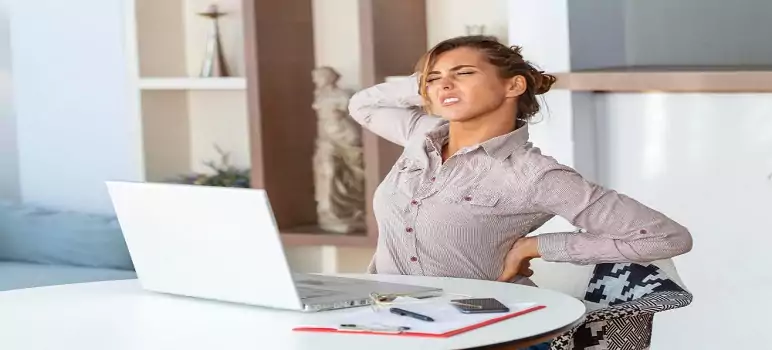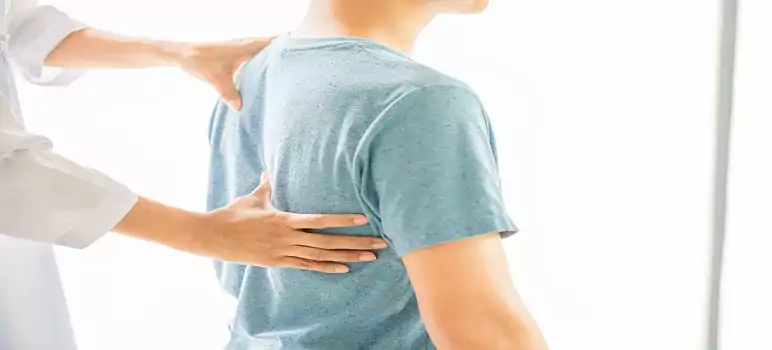What are the causes of lower back pain in female and male: The majority of people will at some point in their lives deal with lower back pain. Back pain has a mechanical cause in about 97 percent of cases and will resolve soon. But other possible causes must be considered as soon as possible because many of these needs very specialised nonsurgical or surgical treatment.
The effectiveness of the treatment option selected for the specific patient will be maximised with careful, early attention to acquire the accurate diagnosis.
Getting medical help right away is necessary if your back pain is caused by a fever, a loss of leg strength or sensation, or trouble urinating. Patients can exercise and learn lifting and movement strategies for future episodes prevention in cases where back pain is caused by a mechanical issue.

Symptoms of Low Back Pain
Lower back pain symptoms may start out gradually or unexpectedly. Pain might sometimes develop following a certain action, like bending to pick up something. Sometimes, the cause of your pain may be a unknown.
Pain can radiate to your bottom or down the back of your legs, and it can be either intense or dull and achy (sciatica). You can hear a “pop” if you strain your back while doing something. Pain frequently gets worse when you bend over and gets better when you lie down.
Other lower back pain signs and symptoms include:
- Posture issues
It might be challenging for many back-pain sufferers to stand up straight. Instead of having your torso in line with your spine, you can stand “crooked” or bent, with your shoulders out to the side. Your lower back might appear flat rather than bent.
- Muscle spasms
Lower back muscles that have been strained may violently contract or spasm after the injury. Extreme pain and difficulty or impossibility in standing, walking, or moving can be brought on by muscle spasms.
- Stiffness
You could find it difficult to move or extend your back. It might take some time for you to stand up from a seated posture, and you might need to stretch or go for a stroll to loosen yourself. You can experience reduced range of motion.
You may also like:
- 8 Most Common Causes of Urinary Tract Infections – Risk Factors & Prevention
- Causes of Gout Disease- Symptoms, Low-Cost Gout Treatment
What are the causes of lower back pain
- Fractures
In an accident, such as a vehicle crash or a tumble, the spine’s bones may shatter. Fractures are more likely to occur in people who have certain diseases, such as osteoporosis or spondylolysis.
- Problems with disk
Disks protect the vertebrae (small spinal bones). Due to their location in the spine, discs may swell and press against a nerve. They may even rip (herniated disk). Disks may become flatter and less protective as they age (degenerative disc disease).
- Structural issues
When the spinal column is too small for the spinal cord, a disease known as spinal stenosis results. Serious sciatic nerve pain and lower back pain might result from something squeezing the spinal cord. Back curvature, or scoliosis, can cause discomfort, stiffness, and trouble moving.
- Disease
Back pain can be brought on by infections, cancer, and spinal tumours. Back discomfort might also be caused by other conditions. These include abdominal aortic aneurysm and kidney stones.
- Spondylolisthesis
This condition causes in the slippage of the vertebrae in the spine. Low back pain from spondylolisthesis frequently includes leg pain as well.
- Strains and sprains
The most common cause of back pain is a back strain or sprain. If you lift something too heavy or improperly, you could damage your muscles, tendons, or ligaments. Sneezing, coughing, twisting, or leaning over might cause some people to strain their backs.
- Arthritis
The most common type of arthritis that causes lower back pain is osteoarthritis.
Other causes of lower back pain
- Your Luggage
Although you may carry your purse, backpack, or briefcase over your shoulder, the lower back is responsible for supporting the upper body, including any additional weight you carry. On the other hand, a filled bag can put stress on the lower back, especially if it is carried every day. If you need to transport a large object, think about using a wheeled briefcase.
- Your Job
If your job requires lifting, pulling, or twisting the spine, it may contribute to back pain However, if your chair is unpleasant or you slump while working, sitting at a desk all day comes with its own set of dangers.
- Posture
This includes sitting with good lumbar support for your lower back, shoulders back, and feet on a low stool. When standing, keep your weight evenly distributed on both feet.
- Workout
Overexertion at the gym or on the golf course is one of the most common causes of overextended muscles that result in low back pain. You’re especially vulnerable if you’re inactive during the week and then spend hours on the weekend at the gym or softball field.
You may also like:
- 12 Most Common Causes of Kidney Stones and How They Are Treated
- Causes of high cholesterol and triglycerides- How to reduce!
Treatments for lower back pain

Rest, ice, and over-the-counter pain relievers are commonly used to treat lower back pain. After a few days of rest, you can resume your normal activities. Staying active increases blood flow to the affected area and helps in healing.
Other treatments for lower back pain, depending on the cause, are as follows:
- Medications
Your doctor may suggest the following, depending on the sort of back pain you have:
Muscle relaxants
Your doctor might also recommend a muscle relaxant if your mild to moderate back pain doesn’t get better after using over-the-counter pain medicines. You may feel groggy and tired after taking muscle relaxants.
Topical painkillers
These medications deliver painkillers through your skin in the form of creams, salves, ointments, or patches.
Drugs
Oxycodone and hydrocodone are examples of opioids that may be used for a brief period of time under the watchful supervision of your doctor. Your prescription will often only include enough tablets for less than a week because opioids don’t effectively treat persistent pain.
Antidepressants
It has been demonstrated that several antidepressants, including duloxetine (Cymbalta) and tricyclic antidepressants like amitriptyline, can treat chronic back pain without affecting depression.
- Surgery
Surgery may be beneficial if you experience persistent pain caused by radiating leg pain or progressive muscle weakening caused on by nerve compression. These procedures are often only used when other treatments have failed to relieve pain caused by structural issues, such as a herniated disc or narrowing of the spine (spinal stenosis).
- Physical therapy
A physical therapist can teach you exercises to improve your posture, increase your flexibility, and strengthen your back and abdominal muscles. The use of these techniques on a regular basis can help prevent pain from returning.
Physical therapists will also educate you on how to modify your movements during a back pain episode to avoid flaring pain symptoms while remaining active.
- Yoga
Yoga may be able to help if back pain doesn’t go away after three months. In one study, participants who participated in a 12-week yoga program experienced less back discomfort than those who received a book on the subject. The advantages persisted for a while. Just make sure you have professional advice to avoid hurting yourself.
- Back strengthening
Your lower back can benefit from strength training. Exercises that include flexion involve bending forward to stretch and build the back and hip muscles. Bending backward during extension exercises helps to build the spine’s supporting muscles. Ask your doctor or physical therapist for advice on safe workouts if you suffer from back pain.
- Injections
Medication is injected with a needle by your doctor into the painful spot. Injections of steroids lessen inflammation and ease pain.
- Physical manipulation
Several “hands-on” techniques can loosen up tense muscles, lessen pain, and enhance alignment and posture. You might require a chiropractic adjustment or an osteopathic manipulation, depending on the source of your pain. Back pain alleviation and function can both be helped by massage treatment.
How common is lower back pain?
Every third adult experiences low back pain at some point. Adults contact doctors for back discomfort more frequently than any other ailment, making it the top orthopedic complaint. It prevents people from going to work, disrupts leisure time, and prevents people from exercising.
The good news is that 90% of low back pain sufferers have acute discomfort, which is transient and subsides in a few days or weeks. However, some low back pain instances take much longer to get better, and some require testing to rule out causes other than muscular strain or arthritis.
You may also like:
- Causes of Migraine in Male, Female- Types of Migraines and Symptoms, treatment
- What happens when you stop taking birth control Pills- 10 Surprising Facts!
How to prevent lower back pain- Causes of lower back pain
You cannot prevent lower back pain caused by disease or structural issues with the spine. However, back pain-causing injuries are preventable.
Your chance of suffering a back injury should be decreased by:
- Keep your weight in check; being overweight increases stress on the discs and vertebrae.
- Boost the strength of your abdominal muscles with Pilates and other training regimens. These muscles support the spine.
- The best approach to lift is with your legs to prevent injury (not your back). Keep bulky objects close to your body. While lifting, try to keep your torso straight.